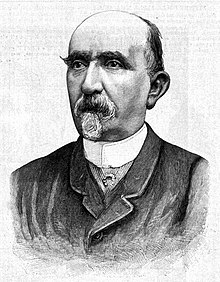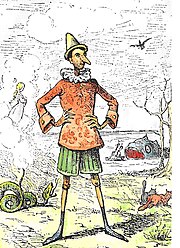Carlo Collodi
This article includes a list of general references, but it lacks sufficient corresponding inline citations. (July 2012) |
Carlo Collodi | |
|---|---|
 | |
| Born | 24 November 1826 Florence, Grand Duchy of Tuscany |
| Died | 26 October 1890 (aged 63) Florence, Italy |
| Occupation | Writer, Novelist |
| Genre | Children's literature |
Carlo Lorenzini, better known by the pen name Carlo Collodi (Italian pronunciation: [ˈkarlo kolˈlɔːdi]; 24 November 1826 – 26 October 1890), was a children's writer born in the Grand Duchy of Tuscany and writer of the world-renowned fairy tale novel The Adventures of Pinocchio.
Early life
Collodi was born in Florence on 24 November 1826. He spent most of his childhood in the town of Collodi where his mother was born. His mother was a farmer's daughter and his father was a cook. He had 10 other siblings but seven died at a young age.
Career
During the Italian wars of Independence in 1848 and 1860 Collodi served as a volunteer with the Tuscan army. His active interest in political matters may be seen in his earliest literary works as well as in the founding of the satirical newspaper Il Lampione in 1853. This newspaper was censored by order of the Grand Duke of Tuscany.[1] In 1854 he published his second newspaper, Lo scaramuccia ("The Controversy").[1]
Lorenzini's first publications were in his periodicals. A debut came in 1856 with the play Gli amici di casa and parodic guidebook Un romanzo in vapore, both in 1856;[2] he had also begun intense activity on other political newspapers such as Il Fanfulla; at the same time he was employed by the Censorship Commission for the Theatre. During this period he composed various satirical sketches and stories (sometimes simply by collating earlier articles), including Macchiette (1880), Occhi e nasi (1881), Storie allegre (1887).[3]
In 1875 he entered the domain of children's literature with Racconti delle fate, a translation of French fairy tales by Perrault. In 1876 Lorenzini wrote Giannettino (inspired by Alessandro Luigi Parravicini's Giannetto), the Minuzzolo, and Il viaggio per l'Italia di Giannettino, a pedagogic series which explored the re-unification of Italy through the ironic thoughts and actions of the character Giannettino.[3]
Lorenzini became fascinated by the idea of using an amiable, rascally character as a means of expressing his own convictions through allegory. In 1880 he began writing Storia di un burattino ("The story of a marionette"), also called Le avventure di Pinocchio, which was published weekly in Il Giornale per i Bambini, the first Italian newspaper for children.[3]
Death
Lorenzini died in Florence in 1890, unaware of the fame and popularity that awaited his work. He is buried at San Miniato al Monte Basilica.[citation needed]
References
- ^ a b Jack Zines. «Introduction». In: Carlo Collordi. Pinnochio. Penguin Books 2002. ISBN 0-14-243706-9
- ^ Carlo Collodi: other works; pinocchio.it
- ^ a b c Gaetana Marrone; Paolo Puppa (26 December 2006). Encyclopedia of Italian Literary Studies. Routledge. pp. 485–. ISBN 978-1-135-45530-9.
External links

 Works by or about Carlo Collodi at Wikisource
Works by or about Carlo Collodi at Wikisource Media related to Carlo Collodi at Wikimedia Commons
Media related to Carlo Collodi at Wikimedia Commons- Pinocchio Park Collodi Tuscany
- New York Review of Books
- Carlo Collodi National Foundation Collodi Tuscany
- Works by Carlo Collodi at Project Gutenberg
- Project Gutenberg e-text of The Adventures of Pinocchio (translated from the Italian by Carol Della Chiesa)
- Works by or about Carlo Collodi at the Internet Archive
- Works by Carlo Collodi at LibriVox (public domain audiobooks)

- Find-A-Grave profile for Carlo Collodi
- Carlo Collodi and Modern Politics - Any Parallels ?
- from "Pinocchio. Le avventure di un burattino" listen to chapt.1 - 2 - 12 audio mp3 for free
- 1826 births
- 1890 deaths
- People from Florence
- 19th-century journalists
- 19th-century Italian novelists
- Italian short story writers
- Italian male short story writers
- Italian fantasy writers
- Italian people of the Italian unification
- Italian children's writers
- Italian journalists
- Italian male novelists
- Male journalists
- Pinocchio
- People of the Revolutions of 1848
- Writers from Tuscany
- 19th-century short story writers
